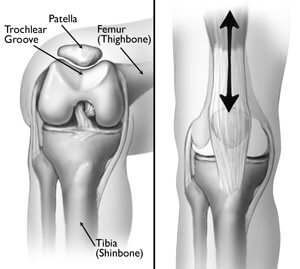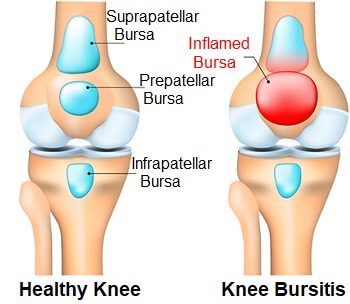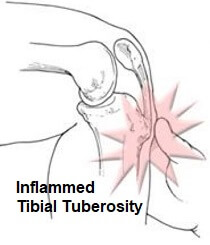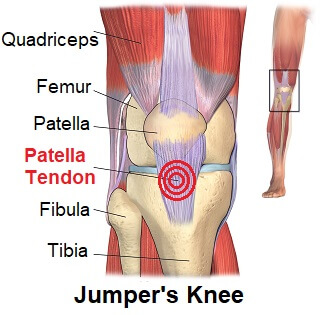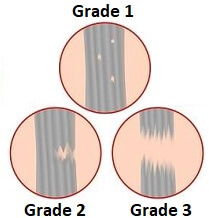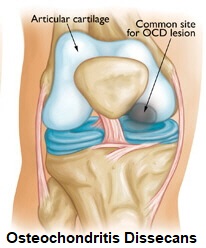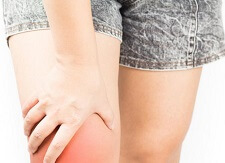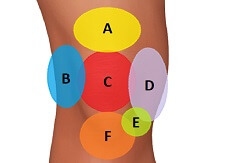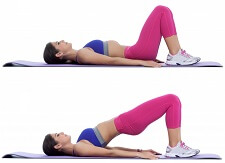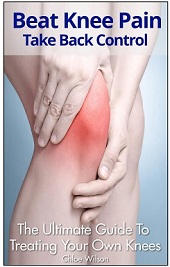- Home
- Knee Pain Diagnosis
- Front Knee Pain
Front Knee Pain
Written By: Chloe Wilson, BSc(Hons) Physiotherapy
Reviewed by: KPE Medical Review Board
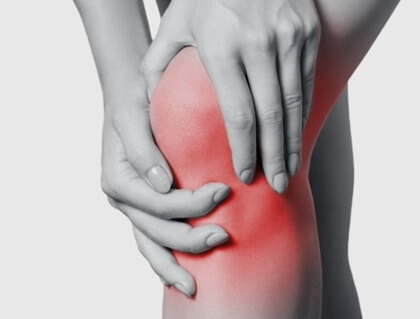
Front knee pain, aka anterior knee pain, is extremely common. In fact it is the most common reason people consult a knee specialist.
There may be a general ache at the front of the knee, a specific sharp pain that you suffer from, swelling or a feeling of instability.
Anterior knee pain may limit your day to day activities, stop you participating in sports or even affect your sleep. But the good news is, there is lots that you can do to help.
If you pain is more at the top of the knee or in the lower thigh, then check out the Pain Above The Knee article.
What Causes Anterior Knee Pain?
The most common causes of anterior knee pain are:
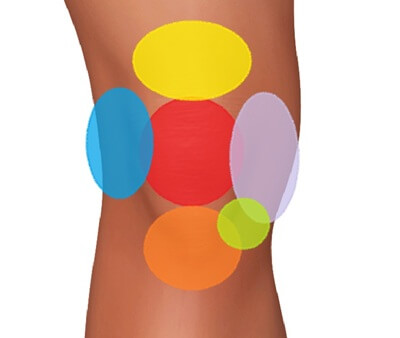
- Runners Knee: a problem with how the kneecap moves
- Bursitis: inflammation of an anti-friction bag
- Osgood Schlatters: bone irritation linked with growth spurts
- Tendonitis: in the quadriceps or patella tendon
- Cartilage Damage: kneecap or knee joint cartilage
- Plica Syndrome: inflammation of the knee lining
- Knee Arthritis: wear and tear
Common Causes Of Front Knee Pain
We'll start by looking at the most common causes of pain in front of the knee and then go on to look at some of the more rare ones.
1. Runners Knee
The most common cause of front knee pain is Runners Knee, aka Patellofemoral Pain Syndrome or Anterior Knee Pain. But don't be fooled by the name - it is just as likely to affect office workers as it is runners!
Runners knee is caused by a problem in how the kneecap moves and accounts for a quarter of all knee injuries seen in clinics.
Typical symptoms of runners knee include a general ache around the front of the knee and patellofemoral pain, a grinding sensation with knee movement and mild swelling at the front of the knee.
Symptoms typically develop gradually over time, rather than due to a knee injury, and pain in front of the knee from patellofemoral pain syndrome typically gets worse with repetitive activities e.g. running or jumping, stairs and prolonged inactivity.
You can find out loads more about the common causes, symptoms and best treatment options in the Runners Knee section.
2. Chondromalacia Patella
A common cause of front knee pain in young, healthy individuals is chondromalacia patella.
Chondromalacia patella is caused by inflammation and tearing of the cartilage that lines the back of the kneecap resulting in patellofemoral pain.
Common symptoms of chondromalacia include an achy pain in front of knee, swelling, clicking sounds and grinding sensations with knee movement. Chondromalacia symptoms typically get worse when you first stand up, play sports, come downstairs or apply any pressure through the kneecap.
You can find out all about the different causes, symptoms, diagnosis and treatment options in the Chondromalacia Patella section.
3. Knee Bursitis
Another common cause of anterior knee pain is knee bursitis.
Knee bursitis is where there is inflammation of the one of the knee bursa - small fluid filled sacs found at various points around the knee.
Knee bursitis tends to develop gradually over time, typically affecting people who spend a lot of time kneeling e.g. carpet layers, plumbers, housewives, gardeners. It can also develop after a blow to the front of the knee
Typical symptoms of knee bursitis include knee pain in the front, redness and a pocket of swelling at the front of the knee - like a squashy orange. Front knee pain from bursitis typically gets worse when kneeling, walking or bending the knee.
There are four types of bursitis that can cause pain and swelling in front of the knee:
- Prepatellar Bursitis: swelling in front of knee cap
- Suprapatellar Bursitis: swelling above the knee
- Infrapatellar Bursitis: front knee swelling below the kneecap
- Pes Anserine Bursitis: medial front knee swelling
Find out all about the different types of knee bursitis and how to treatment them in the Knee Bursitis section.
4. Osgood Schlatters
Osgood Schlatters Disease is the most common cause of front knee pain in children and adolescents.
Osgood schlatters is caused by irritation of the bone just below the kneecap, usually following a growth spurt due.
The most classic feature of osgood schlatters is a tender bony lump in front of the knee, just below the kneecap, causing anterior knee pain.
Symptoms typically get worse with sports activities such as kicking, jumping and running but respond very well to stretching programs.
You can find out all about the causes, symptoms, treatment options and best exercises to reduce front knee pain in the Osgood Schlatters Disease section.
5. Patellar Tendonitis
Another possible cause of pain in front of the knee is Patellar Tendonitis, aka Jumper's Knee.
Patellar tendonitis is caused by damage to the tendon that sits just below the knee cap, most typically from sports involving lots of jumping or kicking.
Jumper's knee typically results in anterior knee pain just below the patella, aching and stiffness after activity. There may also be thickening of the patella tendon resulting in a lump in front of the knee and the tendon is often tender to touch.
You can find out loads more about the common causes, symptoms and treatment options in the Patellar Tendonitis section.
6. Meniscus Tear
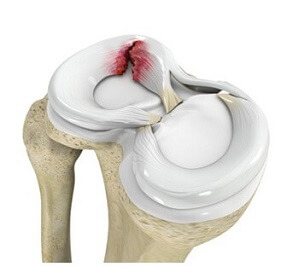
A common cause of anterior knee pain following an injury is a meniscus tear aka torn knee cartilage.
The meniscus is a special, thick layer of cartilage found in the knee. The meniscus may be torn with a knee injury from sudden twisting or overloading of the knee, or tears may develop gradually due to repetitive wear and tear.
Typical symptoms of meniscus tears include knee swelling, locking (where the knee gets stuck), instability, difficulty straightening the knee and catching pain with knee movements.
Knee pain on the front from a meniscus tear often gets worse when weight-bearing e.g. walking or running, on stairs and when squatting.
Find out all about cartilage injuries and how best to treat them in the Meniscus Tear section.
7. Knee Arthritis
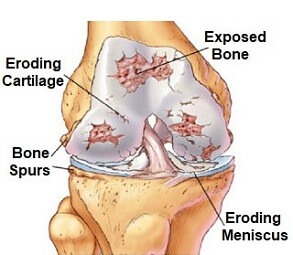
The most common cause of front knee pain in people over the age of 50 is knee arthritis.
Knee arthritis may be caused by wear and tear and degeneration of the knee cartilage with the formation of bone spurs, known as osteoarthritis, or inflammation in the joint, known as rheumatoid arthritis.
Common symptoms of knee arthritis include morning stiffness in the knee, generalized swelling, knee clicking or grinding and joint stiffness with loss of end range movements.
The symptoms of knee arthritis tend to be worse after resting, in cold weather and after activities.
The Knee Arthritis section has loads of information and covers everything you need to know including the causes, symptoms, stages of arthritis and best treatment options.
8. Plica Syndrome
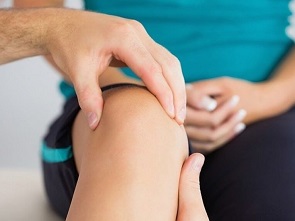
Another possible cause of anterior knee pain which often goes undiagnosed is knee plica syndrome.
Plica syndrome occurs when there is inflammation in the folds of the synovial membrane that lines the knee joint.
Knee plica syndrome may develop suddenly with a knee injury such as a dashboard injury or fall onto the knee, or gradually from repetitive knee bending or kicking or sudden increases in activity.
Common symptoms of knee plica syndrome include dull, achy front knee pain, knee instability, locking, clicking and stiffness. Anterior knee pain from plica syndrome typically gets worse after activity or with knee flexion.
You can find out all about the causes, symptoms, diagnosis and treatment in the Knee Plica Syndrome section.
Rarer Causes of Anterior Knee Pain
We have looked at the most common causes of front knee pain, but there are a few other possible options, if none of them are sounding quite like your problem.
1. Quadriceps Tendonitis
CLASSIC SYMPTOMS: Pain in front of knee just above the patella that gets worse with activity, weakness, stiffness, knee swelling.
What Is Quads Tendonitis: Small tears in the quadriceps tendon above the knee resulting in degeneration and inflammation which may form a lump in front of knee
Onset: Tends to come on gradually over time, affecting people who do lots of jumping and sprinting activities
Treatment: Rest, ice, strengthening & stretching exercises, knee straps, physical therapy and sometimes surgery
Find Out More: Learn more about the causes, symptoms and treatment in the Quadriceps Tendonitis section.
2. Knee Ligament Sprain
CLASSIC SYMPTOMS: Instability - knee gives way, knee swelling, bruising at time of injury, generalised pain and stiffness i.e. reduced knee movement.
What Is A Knee Sprain: Overstretching or tearing one of the ligaments in the knee. There are three grades of sprain depending on the severity of the injury
Aggravating Activities: Depends on the severity but likely to be any weight-bearing activity
Onset: Sudden twisting movements or a force through the knee
Treatment: PRICE, exercises, braces.
Find Out More: Learn more about the causes, symptoms and treatment in the
Knee Ligament Sprain
section.
3. Quadriceps Strain
CLASSIC SYMPTOMS: Anterior thigh pain, swelling and bruising, limited function e.g. stairs and getting in and out of a chair
What Is A Quads Strain: Overstretching or tearing one of the four quadriceps muscles
Aggravating Activities: Running, jumping, kicking, stairs, getting in and out of a chair
Onset: Thigh pain and swelling following forceful knee extension
Find Out More: Learn more about the causes, symptoms and treatment in the Pulled Quad section.
4. Patella Alta
CLASSIC SYMPTOMS: Knee pain on the front, instability, recurrent knee dislocation, positive camel back and grasshopper eyes sign
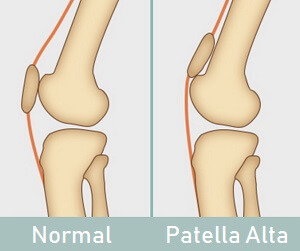
What Is Patella Alta: High riding patella where the kneecap sits too high on the thigh bone and therefore lacks structural support
Aggravating Activities: Walking, running, squatting, prolonged sitting, stairs
Onset: Typically a congenital defect but can develop after a knee injury e.g. patellar tendon rupture
Treatment: PRICE, exercises, taping, braces, surgery.
Find Out More: Visit the Patella Alta section for in-depth info on the causes, diagnosis and treatment options for high riding patella
5. Osteochondritis Dissecans
CLASSIC SYMPTOMS: Occasional sharp pain with general background ache, clunking sensation with leg movements, locking, weakness, decreased leg movement and swelling. Worse with sports, twisting of the knee and on stairs. Typically affects teenagers.
What is Osteochondritis: Decreased blood supply to the bone causes fragments of bone and cartilage to detach
Onset: Occurs at any age but most prevalent 10-20 year olds. Three times more common in men. Fairly rare cause of anterior knee pain
Treatment: Rest, exercises, brace, surgery.
Find Out More: Visit the
Osteochondritis Dissecans
section for more information
6. Patella Injuries
CLASSIC SYMPTOMS: Usually caused by a fairly major injury resulting in severe pain, front knee swelling & restricted movement. Knee may appear deformed. All knee movements will be painful and restricted.
What is it: Damage to the kneecap such as a dislocation (where it shifts out of place) or a fracture
Onset: Sudden onset from a fall, awkward twisting or RTA. It takes a great deal of force to dislocate or break the patella
Treatment: Rest, knee brace, exercises, taping and in some cases surgery.
Find Out More: About both types of injury and how to treat them in the kneecap injuries section
Anterior Knee Pain Treatment
Treatment for front knee pain will depend in part on what the underlying cause of the pain. Typically, the first step is to treat knee swelling which helps to reduce pain and stiffness in the knee and then begin with a rehab program. Knee strengthening and stretching exercises will help to improve the strength, stability and flexibility of the knee, reduce pain and improve function.
You can find out lots more about how to treat the different causes of anterior knee pain:
- Runners Knee Treatment
- Chondromalacia Patella Treatment
- Prepatellar Bursitis Treatment
- Knee Bursitis Treatment
- Osgood Schlatters Treatment
- Patellar Tendonitis Treatment
- Knee Plica Treatment
- Knee Arthritis Treatment
One thing to bear in mind is that just because there is pain in front of the knee, this doesn't necessarily mean the problem is in the anterior knee. Pain often refers to different places. If you would like some help working out what is causing your problem and what you can do about it, visit the knee pain diagnosis section. And remember, the best way to accurately diagnose your front knee pain is to see your doctor.
Front Knee Pain Summary
Front knee pain is extremely common, but is usually fairly simple to overcome. In most cases, with the right treatment, symptoms will start to subside within a few weeks and most people make a full recovery.
Anterior knee pain is often caused by overuse or strain on the muscles and tendons of the knee joint. Treatment will depend on the severity of the pain, but physical therapy, stretching, and strengthening exercises can help to relieve symptoms. Resting, icing, and taking non-steroidal anti-inflammatory medications are also recommended. Surgery may be necessary for more severe cases of front knee pain but this is rare.
If you have significant swelling associated with your anterior knee pain, check out the Front Knee Swelling and Swelling Above The Knee articles.
You might also be interested in the following articles:
- Knee Pain & Popping
- Above Knee Pain
- Pain Below Knee
- Pain Behind The Knee
- Side Knee Pain
- Sharp Knee Pain
- Burning Knee Pain
- Knee Pain At Night
- Knee Pain On Stairs
Related Articles
Page Last Updated: July 3rd, 2025
Next Review Due: July 3rd, 2027
